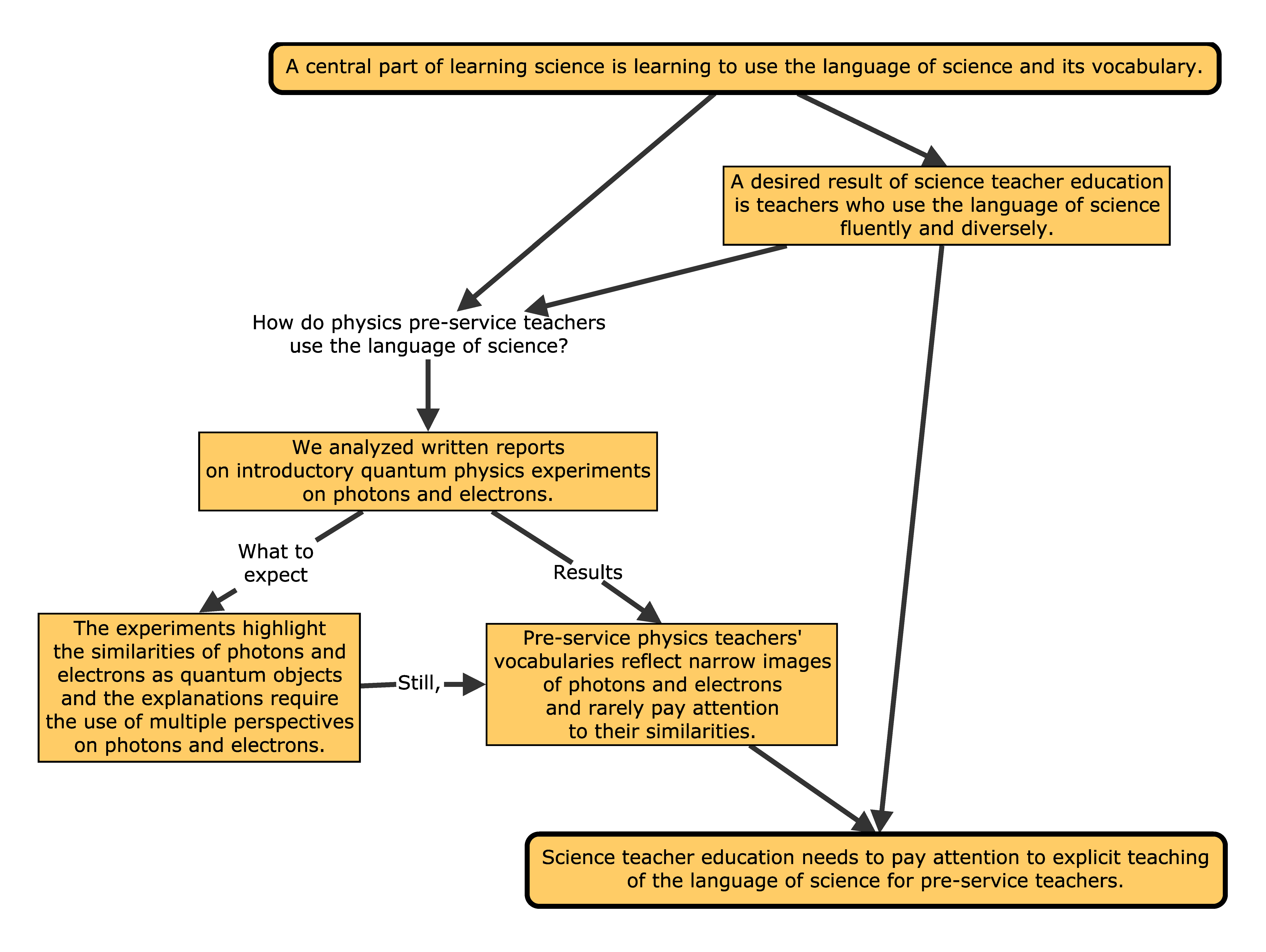Pre-service teachers’ vocabularies of the language of science in the context of learning about electrons and photons
DOI:
https://doi.org/10.31129/LUMAT.11.2.1924Keywords:
the language of science, pre-service teachers, quantum physics, vocabularyAbstract
Teaching and learning the language of science is an important part of science education. Learning the vocabulary of science plays a key role in learning the language of science. The meaning of abstract scientific terms builds on their connections with other terms and how they are used. In this research, we study pre-service physics teachers’ physics-related vocabularies and investigate how rich a vocabulary they use and what similarities and differences there are in their vocabularies regarding electrons and photons. We investigate the connectedness of physics terms by categorizing them according to their role in explaining quantum physics and carry out a lexical network analysis for N=60 written reports. The analysis shows that vocabularies do not share much similarity and the reports reflect narrow images of photons and electrons. We conclude that science teacher education needs to pay attention to explicit teaching of the language of science for pre-service teachers.
References
Ayene, M., Krick, J., Damitie, B., Ingerman, A., & Thacker, B. (2019). A Holistic Picture of Physics Student Conceptions of Energy Quantization, the Photon Concept, and Light Quanta Interference. International Journal of Science and Mathematics Education, 17(6), 1049–1070. https://doi.org/10.1007/s10763-018-9906-y DOI: https://doi.org/10.1007/s10763-018-9906-y
Bratkovich, M. O. (2018). Shining Light on Language for, in, and as Science Content. Science & Education, 27(7), 769–782. https://doi.org/10.1007/s11191-018-9998-3 DOI: https://doi.org/10.1007/s11191-018-9998-3
Cheong, Y. W., & Song, J. (2014). Different Levels of the Meaning of Wave-Particle Duality and a Suspensive Perspective on the Interpretation of Quantum Theory. Science & Education, 23(5), 1011–1030. https://doi.org/10.1007/s11191-013-9633-2 DOI: https://doi.org/10.1007/s11191-013-9633-2
Estrada, E. (2012). The Structure of Complex Networks: Theory and Applications. OUP Oxford. DOI: https://doi.org/10.1093/acprof:oso/9780199591756.001.0001
Fang, Z. (2006). The Language Demands of Science Reading in Middle School. International Journal of Science Education, 28(5), 491–520. https://doi.org/10.1080/09500690500339092 DOI: https://doi.org/10.1080/09500690500339092
Glynn, S. M., & Muth, K. D. (1994). Reading and writing to learn science: Achieving scientific literacy. Journal of Research in Science Teaching, 31(9), 1057–1073. https://doi.org/10.1002/tea.3660310915 DOI: https://doi.org/10.1002/tea.3660310915
Halldén, O., Haglund, L., & Strömdahl, H. (2007). Conceptions and Contexts: On the Interpretation of Interview and Observational Data. Educational Psychologist, 42(1), 25–40. https://doi.org/10.1080/00461520709336916 DOI: https://doi.org/10.1080/00461520709336916
Hobson, A. (2005). Electrons as field quanta: A better way to teach quantum physics in introductory general physics courses. American Journal of Physics, 73(7), 630–634. https://doi.org/10.1119/1.1900097 DOI: https://doi.org/10.1119/1.1900097
Keys, C. W., Hand, B., Prain, V., & Collins, S. (1999). Using the Science Writing Heuristic as a Tool for Learning from Laboratory Investigations in Secondary Science. Journal of Research in Science Teaching, 36(10), 1065–1084. https://doi.org/10.1002/(SICI)1098-2736(199912)36:10<1065::AID-TEA2>3.0.CO;2-I DOI: https://doi.org/10.1002/(SICI)1098-2736(199912)36:10<1065::AID-TEA2>3.0.CO;2-I
Koponen, I. T., & Nousiainen, M. (2020). Lexical Networks and Lexicon Profiles in Didactical Texts for Science Education. In H. Cherifi, S. Gaito, J. F. Mendes, E. Moro, & L. M. Rocha (Eds.), Complex Networks and Their Applications VIII (Vol. 882, pp. 15–27). Springer International Publishing. https://doi.org/10.1007/978-3-030-36683-4_2 DOI: https://doi.org/10.1007/978-3-030-36683-4_2
Krijtenburg-Lewerissa, K., Pol, H. J., Brinkman, A., & van Joolingen, W. R. (2017). Insights into teaching quantum mechanics in secondary and lower undergraduate education. Physical Review Physics Education Research, 13(1), 010109. https://doi.org/10.1103/PhysRevPhysEducRes.13.010109 DOI: https://doi.org/10.1103/PhysRevPhysEducRes.13.010109
Lachner, A., Jacob, L., & Hoogerheide, V. (2021). Learning by writing explanations: Is explaining to a fictitious student more effective than self-explaining? Learning and Instruction, 74, 101438. https://doi.org/10.1016/j.learninstruc.2020.101438 DOI: https://doi.org/10.1016/j.learninstruc.2020.101438
Lemke, J. L. (1990). Talking Science: Language, Learning, and Values. Ablex Publishing Corporation, 355 Chestnut Street, Norwood, NJ 07648 (hardback: ISBN-0-89391-565-3; paperback: ISBN-0-89391-566-1). https://eric.ed.gov/?id=ED362379
Mäntylä, T., & Nousiainen, M. (2014). Consolidating Pre-service Physics Teachers’ Subject Matter Knowledge Using Didactical Reconstructions. Science & Education, 23(8), 1583–1604. https://doi.org/10.1007/s11191-013-9657-7 DOI: https://doi.org/10.1007/s11191-013-9657-7
Mercer, N. (2009). Developing Argumentation: Lessons Learned in the Primary School. In N. Muller Mirza & A.-N. Perret-Clermont (Eds.), Argumentation and Education: Theoretical Foundations and Practices (pp. 177–194). Springer US. https://doi.org/10.1007/978-0-387-98125-3_7 DOI: https://doi.org/10.1007/978-0-387-98125-3_7
Nousiainen, M. (2017). Organization of physics content knowledge for teaching purposes: From knowledge justification schemes to didactical schemes. European Journal of Science and Mathematics Education, 5(2), 210–221. https://doi.org/10.30935/scimath/9507 DOI: https://doi.org/10.30935/scimath/9507
Nousiainen, M., & Koponen, I. T. (2020). Pre-Service Teachers’ Declarative Knowledge of Wave-Particle Dualism of Electrons and Photons: Finding Lexicons by Using Network Analysis. Education Sciences, 10(3), 76. https://doi.org/10.3390/educsci10030076 DOI: https://doi.org/10.3390/educsci10030076
Schleppegrell, M. J. (2004). The Language of Schooling: A Functional Linguistics Perspective. Routledge. https://doi.org/10.4324/9781410610317 DOI: https://doi.org/10.4324/9781410610317
Schwarz, B. B. (2009). Argumentation and Learning. In N. Muller Mirza & A.-N. Perret-Clermont (Eds.), Argumentation and Education: Theoretical Foundations and Practices (pp. 91–126). Springer US. https://doi.org/10.1007/978-0-387-98125-3_4 DOI: https://doi.org/10.1007/978-0-387-98125-3_4
Södervik, I., Nousiainen, M., & Koponen, Ismo. T. (2021). First-Year Life Science Students’ Understanding of the Role of Plants in the Ecosystem—A Concept Network Analysis. Education Sciences, 11(8), 369. https://doi.org/10.3390/educsci11080369 DOI: https://doi.org/10.3390/educsci11080369
Stenhouse, D. (1986). Conceptual Change in Science Education: Paradigms and Language-Games. Science Education, 70(4), 413–425. DOI: https://doi.org/10.1002/sce.3730700407
Wellington, J. J., & Osborne, J. (2001). Language and literacy in science education. Open University.
Yun, E. (2020). Language gap between college introductory physics textbooks and high school physics textbooks. European Journal of Physics, 41(6), 065704. https://doi.org/10.1088/1361-6404/abbaae DOI: https://doi.org/10.1088/1361-6404/abbaae
Yun, E., & Park, Y. (2018). Extraction of scientific semantic networks from science textbooks and comparison with science teachers’ spoken language by text network analysis. International Journal of Science Education, 40(17), 2118–2136. https://doi.org/10.1080/09500693.2018.1521536 DOI: https://doi.org/10.1080/09500693.2018.1521536

Downloads
Additional Files
Published
How to Cite
Issue
Section
Categories
License
Copyright (c) 2023 Karoliina Vuola, Maija Nousiainen, Ismo T. Koponen

This work is licensed under a Creative Commons Attribution 4.0 International License.









